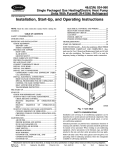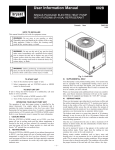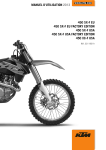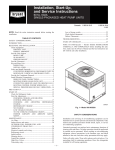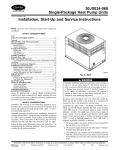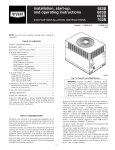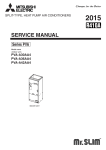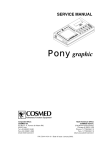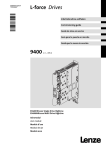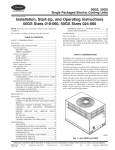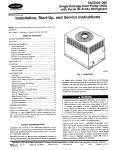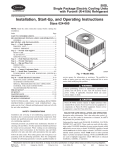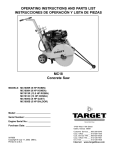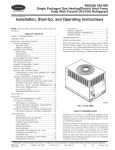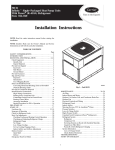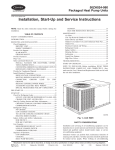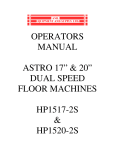Download Installation, Start-Up, and Service Instructions
Transcript
Installation, Start-Up, and Service Instructions 602B SINGLE-PACKAGE HEAT PUMP UNITS WITH PURON (R-410A) REFRIGERANT Cancels: II 602B-24-1 II 602B-24-2 12-00 NOTE: Read the entire instruction manual before starting the installation. This symbol → indicates a change since the last issue. TABLE OF CONTENTS SAFETY CONSIDERATIONS .....................................................1 Introduction ....................................................................................2 Receiving and Installation..............................................................2 Check Equipment......................................................................2 Provide Unit Support ................................................................2 Provide Clearances....................................................................2 Rig and Place Unit....................................................................2 Select and Install Ductwork .....................................................5 Provide for Condensate Disposal .............................................6 Install Electrical Connections...................................................7 PRE-START-UP ..........................................................................10 START-UP ...................................................................................12 Check for Refrigerant Leaks ..................................................12 Start-Up Adjustments..............................................................12 Defrost Control .......................................................................19 MAINTENANCE.........................................................................20 Air Filter..................................................................................22 Indoor Blower and Motor.......................................................22 Outdoor Coil, Indoor Coil, and Condensate Drain Pan ........22 Outdoor Fan ............................................................................22 Electrical Controls and Wiring...............................................22 Refrigerant Circuit ..................................................................22 Indoor Airflow ........................................................................23 Metering Devices–Accurater Piston.......................................23 Pressure Switches....................................................................23 Loss of Charge Switch ...........................................................23 High-Pressure Switch..............................................................23 Copeland Scroll Compressor (Puron Refrigerant).................23 Refrigerant System..................................................................23 System Information.................................................................24 TROUBLESHOOTING ...............................................................24 Start-Up Checklist ........................................................................24 NOTE TO INSTALLER — READ THESE INSTRUCTIONS CAREFULLY AND COMPLETELY before installing this unit. Also, make sure the Owner’s Manual and Service Instructions are left with the unit after installation. C99063 Fig. 1—Unit 602B Follow all safety codes. Wear safety glasses and work gloves. Use quenching cloth for unbrazing operations. Have fire extinguisher available for all brazing operations. WARNING: Improper installation, adjustment, alteration, service, maintenance, or use can cause explosion, fire, electric shock, or other occurrences, which could cause serious injury or death or damage your property. Consult a qualified installer or service agency for information or assistance. The qualified installer or agency must use only factory-authorized kits or accessories when modifying this product. Recognize safety information. This is the safety-alert symbol . When you see this symbol on the product or in instructions or manuals, be alert to the potential for personal injury. Understand the signal words — DANGER, WARNING, CAUTION, and NOTE. Danger identifies the most serious hazards, which will result in severe personal injury or death. Warning indicates a condition that could cause serious personal injury or death. Caution is used to identify unsafe practices, which would result in minor personal injury or product and property damage. NOTE is used to highlight suggestions which will result in enhanced installation, reliability, or operation. SAFETY CONSIDERATIONS Installation and servicing of air-conditioning equipment can be hazardous due to system pressure and electrical components. Only trained and qualified personnel should install, repair, or service air-conditioning equipment. Untrained personnel can perform basic maintenance functions of cleaning coils and filters. All other operations should be performed by trained service personnel. When working on air-conditioning equipment, observe precautions in the literature, tags, and labels attached to the unit, and other safety precautions that may apply. 1. The power supply (volts, phase, and hertz) must correspond to that specified on unit rating plate. 2. The electrical supply provided by the utility must be sufficient to handle load imposed by this unit. —1— III. PROVIDE CLEARANCES The required minimum service clearances are shown in Figs. 2 and 3. Adequate ventilation and outdoor air must be provided. The outdoor fan draws air through the outdoor coil and discharges it through the top fan grill. Be sure that the fan discharge does not recirculate to the outdoor coil. Do not locate the unit in either a corner or under an overhead obstruction. The minimum clearance under a partial overhang (such as a normal house overhang) is 48 in. above the unit top. The maximum horizontal extension of a partial overhang must not exceed 48 in. IMPORTANT: Do not restrict outdoor airflow. An air restriction at either the outdoor-air inlet or the fan discharge may be detrimental to compressor life. Do not place the unit where water, ice, or snow from an overhang or roof will damage or flood the unit. Do not install the unit on carpeting or other combustible materials. Slab-mounted units should be at least 4 in. above the highest expected water and runoff levels. Do not use unit if it has been under water. 3. This installation must conform with local building codes and with NEC (National Electrical Code). Refer to provincial and local plumbing or waste water codes and other applicable local codes. WARNING: Before performing service or maintenance operations on system, turn off main power to unit. Turn off accessory heater power switch if applicable. Electrical shock could cause severe injury or death. CAUTION: Puron (R-410A) systems operate at higher pressures than standard R-22 systems. DO not use R-22 service equipment or components on Puron (R-410A) equipment. Ensure service equipment is rated for Puron (R-410A) INTRODUCTION The 602B heat pump is fully self-contained and designed for outdoor installation. (See Fig. 1) Standard units are shipped in a horizontal-discharge configuration for installation on a groundlevel slab. Standard units can be converted to downflow (vertical) discharge configurations for rooftop applications. I. IV. RIG AND PLACE UNIT Rigging and handling of this equipment can be hazardous for many reasons due to the installation location (roofs, elevated structures, etc.) Only trained, qualified crane operators and ground support staff should handle and install this equipment. When working with this equipment, observe precautions in the literature, on tags, stickers, and labels attached to the equipment, and any other safety precautions that might apply. Follow all applicable safety codes. Wear safety shoes and work gloves. RECEIVING AND INSTALLATION CHECK EQUIPMENT A. IDENTIFY UNIT The unit model number and serial number are stamped on the unit identification plate. Check this information against shipping papers. A. INSPECTION Prior to initial use, and at monthly intervals, all rigging brackets and straps should be visually inspected for any damage, evidence of wear, structural deformation, or cracks. Particular attention should be paid to excessive wear at hoist hooking points and load support areas. Brackets or straps showing any kind of wear in these areas must not be used and should be discarded. B. INSPECT SHIPMENT Inspect for shipping damage while unit is still on shipping pallet. If unit appears to be damaged or is torn loose from its anchorage, have it examined by transportation inspectors before removal. Forward claim papers directly to transportation company. Manufacturer is not responsible for any damage incurred in transit. Check all items against shipping list. Immediately notify the nearest Bryant Air Conditioning office if any item is missing. To prevent loss or damage, leave all parts in original packages until installation. II. B. 1. Remove unit from shipping carton. Leave top shipping skid on the unit as a spreader bar to prevent the rigging straps from damaging the unit. If the wood skid is not available, use a spreader bar of sufficient length to protect unit from damage. PROVIDE UNIT SUPPORT 2. Position the lifting bracket assembly around the base of the unit. Be sure the strap does not twist. A. ROOF CURB Install accessory roof curb in accordance with instructions shipped with curb. (See Fig. 5) Install insulation, cant strips, roofing, and flashing. Ductwork must be attached to curb. IMPORTANT: The gasketing of the unit to the roof curb is critical for a watertight seal. Install gasketing material supplied with the roof curb. Improperly applied gasketing also can result in air leaks and poor unit performance. Curb should be level to within 1/4 in. (See Fig. 6) This is necessary for unit drain to function properly. Refer to accessory roof curb installation instructions for additional information as required. B. INSTALLATION 3. Place each of the 4 metal lifting brackets into the handholds in the composite pan. 4. Thread lifting bracket strapping around bottom perimeter of unit as follows: a. Open lever of tension buckle (ratchet type). b. Feed strapping through tension buckle as shown in Fig. 8. c. Pull strapping through tension buckle unit taut. d. Snap lever down to lock strap in tension buckle. To release strapping, squeeze safety latch, lift lever, and pull webbing outward. SLAB MOUNT Place the unit on a solid, level concrete pad that is a minimum of 4 in. thick with 2 in. above grade. (See Fig. 7) The slab should extend approximately 2 in. beyond the casing on all 4 sides of the unit. Do not secure the unit to the slab except when required by local codes. 5. Tighten the tension buckle until it is taut. Lifting brackets must be secure in the handholds. 6. Attach field-supplied clevis or hook of sufficient strength to hole in the lifting bracket. (See Fig. 9) 7. Attach the 2 safety straps directly to the clevis or hook at the 4 rigging brackets. DO NOT attach the safety straps to the lifting brackets. (See Fig. 9) C. GROUND MOUNT The unit may be installed either on a slab or placed directly on the ground if local codes permit. Place the unit on level ground prepared with gravel for condensate discharge. —2— C00160 → UNIT ELECTRICAL CHARACTERISTICS 602B024 602B030 602B036 208/230-1-60 208/230-1-60,208/230-3-60 208/230-1-60,208/230-3-60, 460-3-60 UNIT WEIGHT lb 299 320 328 kg 135.6 145.2 148.8 UNIT HEIGHT IN. (MM) ”A” 35.02 (889.5) 37.02 (940.3) 37.02 (940.3) Fig. 2—602B024-036 Unit Dimensions —3— CENTER OF GRAVITY IN. (MM) X Y 19.0 (482.6) 18.3 (463.6) 16.0 20.0 (508.0) 19.3 (489.0) 17.6 20.0 (508.0) 19.0 (482.6) 16.5 Z (406.4) (447.0) (419.1) C00161 UNIT ELECTRICAL CHARACTERISTICS 602B042 602B048 602B060 208/230-1-60, 208/230-3-60, 460-3-60 208/230-1-60, 208/230-3-60, 460-3-60 208/230-1-60, 208/230-3-60, 460-3-60 UNIT WEIGHT lb 350 355 428 kg 158.8 161.0 194.1 UNIT HEIGHT IN. (MM) ”A” 40.98 (1040.9) 40.98 (1040.9) 42.98 (1091.7) Fig. 3—602B 042-060 Unit Dimensions —4— CENTER OF GRAVITY IN. (MM) X Y 21.0 (533.4) 20.5 (520.7) 16.6 20.0 (508.0) 21.3 (539.8) 18.0 21.0 (533.4) 20.0 (508.0) 17.6 Z (421.6) (457.2) (447.0) 1 2 y 4 3 x → CORNER WEIGHTS (SMALL CABINET) Unit 24 30 Total Weight 299 320 Corner Corner Corner Corner Weight Weight Weight Weight 1 2 3 4 63 62 56 118 63 74 56 127 36 328 64 76 58 130 Model 602B Model 602B C00071 CORNER WEIGHTS (LARGE CABINET) Unit 42 48 Total Weight 350 355 Corner Corner Corner Corner Weight Weight Weight Weight 1 2 3 4 75 49 95 131 76 50 96 133 60 428 92 60 116 160 Fig. 4—Corner Weights 2. Avoid abrupt duct size increases and reductions. Abrupt 8. Position lifting point directly over the unit’s center of change in duct size adversely affects air performance. gravity. 9. Lift unit. When unit is directly over the roof curb, remove IMPORTANT: Use flexible connectors between ductwork and the 2 safety straps. Lower the equipment onto the roof curb. unit to prevent transmission of vibration. Use suitable gaskets to ensure weather tight and airtight seal. When electric heat is 10. After the unit is placed on the roofcurb or mounting pad, installed, use fireproof canvas (or similar heat resistant material) remove the top crating. On 602B060 units only, 2 wire ties connector between ductwork and unit discharge connection. If fastened to the outdoor coils and reversing flexible duct is used, insert a sheet metal sleeve inside duct. Heat valve/accumulator assembly must be cut. Remove the left resistant duct connector (or sheet metal sleeve) must extend 24-in. and front louver panels and corner post to access wire ties. from electric heater element. The wire tie to be cut on the left is located approximately 4 in. down the tube sheet. The wire tie to be cut on the right 3. Size ductwork for cooling air quantity (cfm). The minimum is located approximately 6 in. down the tube sheet. air quantity for proper electric heater operation is listed in V. SELECT AND INSTALL DUCTWORK Table 2. Heater limit switches may trip at air quantities below those recommended. The design and installation of the duct system must be in accordance with the standards of the NFPA for installation of 4. Seal, insulate, and weatherproof all external ductwork. Seal, non-residence type air conditioning and ventilating systems, NFPA insulate and cover with a vapor barrier all ductwork passing 90A or residence-type, NFPA 90B and/or local codes and ordithrough conditioned spaces. Follow latest Sheet Metal and nances. Air Conditioning Contractors National Association Select and size ductwork, supply-air registers, and return air grilles (SMACNA) and Air Conditioning Contractors Association according to ASHRAE (American Society of Heating, Refrigera(ACCA) minimum installation standards for residential tion, and Air Conditioning Engineers) recommendations. heating and air conditioning systems. The unit has duct flanges on the supply- and return-air openings on 5. Secure all ducts to building structure. Flash, weatherproof, the side of the unit. and vibration-isolate duct openings in wall or roof accordWhen designing and installing ductwork, consider the following: ing to good construction practices. A. CONVERTING HORIZONTAL DISCHARGE UNITS TO DOWNFLOW (VERTICAL) DISCHARGE UNITS WARNING: For vertical supply and return units, tools or parts could drop into ductwork and cause serious injury or death. Install a 90 degree turn in the return ductwork between the unit and the conditioned space. If a 90 degree elbow cannot be installed, then a grille of sufficient strength and density should be installed to prevent objects from falling into the conditioned space. Units with electric heaters require 90 degree elbow in supply duct. WARNING: Before performing service or maintenance operations on system, turn off main power to unit. Turn off accessory heater power switch if applicable. Electrical shock could cause serious injury or death. 1. Open all electrical disconnects before starting any service work. 2. Remove horizontal duct covers to access bottom return and supply knock out panels. 1. All units should have field-supplied filters or accessory filter rack installed in the return-air side of the unit. Recommended sizes for filters are shown in Table 1. —5— HVAC unit base HVAC unit base Screw (NOTE A) Screw (NOTE A) Gasketing inner flange* *Gasketing outer flange Gasketing inner flange* *Gasketing outer flange Wood nailer* Flashing field supplied Wood nailer* Flashing field supplied Roofcurb* Insulation (field supplied) Roofing material field supplied Roofing material field supplied Duct work field supplied Cant strip field supplied Roofcurb* Insulation (field supplied) Duct work field supplied Cant strip field supplied Roof Roof *Provided with roofcurb *Provided with roofcurb Roof Curb for Small Cabinet Roof Curb for Large Cabinet Note A: When unit mounting screw is used, retainer bracket must also be used. Note A: When unit mounting screw is used, retainer bracket must also be used. Supply opening (B x C) B Typ. 44 5/16" D C Typ. R/A A Insulated deck pan Short Support Insulated deck pan S/A Gasket around duct Gasket around outer edge Long Support Return opening (B X C) C00076 UNIT SIZE 602B024-036 602B042-060 → ODS CATALOG NUMBER CPRFCURB006A00 CPRFCURB007A00 CPRFCURB008A00 CPRFCURB009A00 A IN. (MM) 8 (203) 14 (356) 8 (203) 14 (356) B IN. (MM) 11(279) 11(279) 16 3/16 (411) 16 3/16 (411) C IN. (MM) 161/2 (419) 161/2 (419) 17 3/8 (441) 17 3/8 (441) D IN. (MM) 28-3/4 (730) 28-3/4 (730) 40-1/4 (1022) 40-1/4 (1022) NOTES: 1. Roof curb must be set up for unit being installed. 2. Seal strip must be applied, as required, to unit being installed. 3. Dimensions in ( ) are in millimeters. 4. Roof curb is made of 16-gage steel. 5. Table lists only the dimensions, per part number, that have changed. 6. Attach ductwork to curb (flanges of duct rest on curb). 7. Insulated panels: 1-in. thick fiberglass 1 lb. density. 8. Dimensions are in inches. 9. When unit mounting screw is used (see Note A), a retainer bracket must be used as well. This bracket must also be used when required by code for hurricane or seismic conditions. This bracket is available through Micrometl. Fig. 5—Roof Curb Dimensions VI. 3. Use a screwdriver and hammer to remove the panels in the bottom of the base pan. NOTE: These panels are held in place with tabs similar to an electrical knockout. PROVIDE FOR CONDENSATE DISPOSAL NOTE: Ensure that condensate-water disposal methods comply with local codes, restrictions, and practices. The 602B units dispose of condensate through a 3/4 in. NPT female fitting that exits on the compressor end of the unit. Condensate water can be drained directly onto the roof in rooftop installations (where permitted) or onto a gravel apron in ground level installations. Install a field-supplied condensate trap at end of 4. Reinstall the horizontal duct covers (Fig. 11) to block off the horizontal air openings. NOTE: Avoid abrupt duct size increases and reductions. Abrupt change in duct size adversely affects air performance. —6— A OPTIONAL RETURN AIR OPENING C MAXIMUM ALLOWABLE DIFFERENCE (in.) B A-B B-C A-C 1/4 1/4 1/4 OPTIONAL SUPPLY AIR OPENING C99065 Fig. 6—Unit Leveling Tolerances 2" EVAP. COIL condensate connection to ensure proper drainage. Make sure that the outlet of the trap is at least 1 in. lower than the drain-pan condensate connection to prevent the pan from overflowing. Prime the trap with water. When using a gravel apron, make sure it slopes away from the unit. C99096 Fig. 7—Slab Mounting Detail HANDHOLD If the installation requires draining the condensate water away from the unit, install a field-supplied 2 -in. trap at the condensate connection to ensure proper drainage. Condensate trap is available as an accessory or is field-supplied. Make sure that the outlet of the trap is at least 1 in. lower than the unit drain-pan condensate connection to prevent the pan from overflowing. Connect a drain trough using a minimum of field-supplied 3/4-in. PVC or fieldsupplied 3/4-in. copper pipe at outlet end of the 2-in. trap. (See Fig. 12) Do not undersize the tube. Pitch the drain trough downward at a slope of at least 1 in. every 10 ft. of horizontal run. Be sure to check the drain trough for leaks. Prime the trap at the beginning of the cooling season start-up. VII. COND. COIL HOOK FEED C99067 Fig. 8—Threading Belt INSTALL ELECTRICAL CONNECTIONS 914-137" (36"-54") “A” WARNING: The unit cabinet must have an uninterrupted, unbroken electrical ground to minimize the possibility of personal injury if an electrical fault should occur. This ground may consist of an electrical wire connected to the unit ground lug in the control compartment, or conduit approved for electrical ground when installed in accordance with NEC, ANSI/NFPA American National Standards Institute/National Fire Protection Association (latest edition) (in Canada, Canadian Electrical Code CSA C22.1) and local electrical codes. Failure to adhere to this warning could result in serious injury or death. “B” DETAIL A SCALE 0.250 TIGHTEN STRAPPING SECURELY WITH TENSION BUCKLE INSTALL SAFETY STRAPS TO RIGGING CLEVIS AT 4 RIGGING BRACKETS SEE DETAIL A PLACE RIGGING BRACKET ASSEMBLY IN 4 HAND HOLES AND INSTALL TIE DOWN STRAP AROUND PERIMETER OF UNIT AND THROUGH SPACE IN BRACKET ASSEMBLY C99075 UNIT Size 602B024 602B030 602B036 602B042 602B048 602B060 MAXIMUM lb 321 342 350 372 377 450 WEIGHT kg 145.6 155.2 158.8 168.8 171.0 204.2 A in. 19.0 20.0 20.0 21.0 20.0 21.0 mm. 482.6 508 508 533.4 508 533.4 Fig. 9—Suggested Rigging —7— B in. 18.25 19.25 19.0 20.5 21.25 20.0 mm. 463.6 489 482.6 520.7 539.8 508.0 TABLE 1—PHYSICAL DATA—UNIT 602B UNIT SIZE NOMINAL CAPACITY (ton) OPERATING WEIGHT (lb.) COMPRESSOR QUANTITY TYPE REFRIGERANT REFRIGERANT METERING DEVICE Refrigerant (R-410A) Quantity (lb.) ORIFICE ID (in.) ORIFICE OD (in.) OUTDOOR COIL Rows... Fins/in. face area (sq. ft.) OUTDOOR FAN Nominal Airflow (CFM) Diameter Motor HP (RPM) INDOOR COIL Rows... Fins/in. face area (sq. ft.) INDOOR BLOWER Nominal Airflow (CFM) Size (in.) Motor (HP) HIGH-PRESSURE SWITCH (psig) Cutout Reset (Auto) LOSS-OF-CHARGE/LOW-PRESSURE SWITCH (Liquid Line) (psig) Cutout Reset (Auto) RETURN-AIR FILTERS (in.)* throwaway 602B024 2 299 602B030 2-1/2 320 602B036 3 328 602B042 3-1/2 350 602B048 4 355 602B060 5 428 7.0 0.061 0.032 (2) 8.9 0.061 0.040 (2) 1 SCROLL COMPRESSOR R-410A Accurater 9.3 9.5 0.067 0.073 0.040 (2) 0.038 (2) 10.6 0.076 0.046 (2) 12.4 0.088 0.052 (2) 2...17 8.5 2...17 10.3 2...17 10.3 2...17 13.5 2...17 13.5 2...17 15.4 2350 22 1/8 (825) 2350 22 1/8 (825) 2800 22 1/4 (1100) 2500 22 1/8 (825) 3300 22 1/4 (1100) 3300 22 1/4 (1100) 3...15 3.7 3...15 3.7 4...15 3.7 3...15 4.7 4...15 4.7 4...15 5.7 800 10x10 1/4 1000 10x10 1/4 1200 10x10 1/2 1400 11x10 1/2 1600 11x10 1/2 1750 11x10 1 24x30x1 24x30x1 610 ± 15 420 ± 25 20 ± 5 45 ± 10 20x20x1 20x20x1 20x24x1 24x30x1 * Required filter sizes shown are based on the larger of the ARI (Air Conditioning and Refrigeration Institute) rated cooling airflow or the heating airflow velocity of 300 ft/minute for throwaway type or 450 ft/minute for high-capacity type. Air filter pressure drop for non-standard filters must not exceed 0.08 in. wg. TABLE 2—MINIMUM AIRFLOW FOR RELIABLE ELECTRIC HEATER OPERATION (CFM) SIZE AIRFLOW (CFM) 602B024 800 602B030 1000* 602B036 1200 602B042 1400 602B048 1600 602B060 2000 * The 030 size models must be run on medium or high speed when used in conjunction with 15 kw electric heat accessory A. CAUTION: Failure to follow these precautions could result in damage to the unit being installed: 1. Make all electrical connections in accordance with NEC ANSI/NFPA (latest edition) and local electrical codes governing such wiring. In Canada, all electrical connections must be in accordance with CSA standard C22.1 Canadian Electrical Code Part 1 and applicable local codes. Refer to unit wiring diagram. 2. Use only copper conductor for connections between field-supplied electrical disconnect switch and unit. DO NOT USE ALUMINUM WIRE. 3. Be sure that high-voltage power to unit is within operating voltage range indicated on unit rating plate. On 3-phase units, ensure phases are balanced within 2 percent. Consult local power company for correction of improper voltage and/or phase imbalance. 4. Insulate low-voltage wires for highest voltage contained within conduit when low-voltage control wires are in same conduit as high-voltage wires. 5. Do not damage internal components when drilling through any panel to mount electrical hardware, conduit, etc. HIGH-VOLTAGE CONNECTIONS The unit must have a separate electrical service with a fieldsupplied, waterproof disconnect switch mounted at, or within sight from the unit. Refer to the unit rating plate, NEC and local codes for maximum fuse/circuit breaker size and minimum circuit amps (ampacity) for wire sizing (See Table 3 for electrical data). The field-supplied disconnect may be mounted on the unit over the high-voltage inlet hole (See Figs. 2 and 3). If the unit has an electric heater, a second disconnect may be required. Consult the Installation, Start-Up, and Service Instructions provided with the accessory for electrical service connections. Operation of unit on improper line voltage constitutes abuse and may cause unit damage that could affect warranty. B. ROUTING POWER LEADS INTO UNIT Use only copper wire between disconnect and unit. The highvoltage leads should be in a conduit until they enter the duct panel; conduit termination at the duct panel must be watertight. Run the high-voltage leads through the power entry knockout on the power entry side panel. (See Fig. 2 and 3 for location and size) When the leads are inside the unit, run leads up the high-voltage raceway to the line wiring splice box. (See Fig. 13 through 15) For single—8— INDOOR THERMOSTAT RETURN AIR FROM POWER SOURCE TOP COVER DISCONNECT PER NEC* *NEC - NATIONAL ELECTRICAL CODE C00063 Fig. 10—Typical Installation 1” MIN. TRAP OUTLET 2” MIN. C99013 Fig. 12—Condensate Trap The unit transformer supplies 24-v power for complete system including accessory electrical heater. An automatic-reset circuit breaker (See Fig. 19) is provided in the 24-v circuit; see the caution label on the transformer or Fig. 20. Transformer is factory wired for 230-v operation. If supply voltage is 208-v, rewire transformer primary as described in Special Procedures for 208-v Operation section. Duct Covers C00092 E. Fig. 11—602B with Duct Covers On phase units, connect leads to the black and yellow wires; for 3-phase units, connect the leads to the black, yellow, and blue wires. (See Fig. 18) C. CONNECTING GROUND LEAD TO GROUND LUG SPECIAL PROCEDURES FOR 208-V OPERATION 1. Be sure unit disconnect switch is open. 2. Disconnect the yellow primary lead (w 110) from the transformer. See unit wiring label. (See Fig. 13 and 14) Refer to Fig. 18. Connect the ground lead to the chassis using the ground lug in the wiring splice box. D. ROUTING CONTROL POWER WIRES (24-V) Form a drip-loop with the thermostat leads before routing them into the unit. Route the thermostat leads through grommeted, low-voltage hole provided in unit into unit control power splice box. (See Fig. 2 and 3) Connect thermostat leads to unit control power leads as shown in Fig. 17. 3. Connect the yellow primary lead (w110) to the transformer terminal labeled 200-v. Indoor blower-motor speeds may need to be changed for 208-v operation. Refer to indoor airflow and airflow adjustments section. —9— TABLE 3—ELECTRICAL DATA—602B VOLTAGE RANGE Min Max UNIT 602B SIZE V-PH-HZ 024 208/230–1–60 187 208/230–1–60 ODFM FLA IDFM FLA 61.0 0.9 2.0 15.9 73.0 0.9 2.1 253 10.9 63.0 0.9 2.1 187 253 16.9 83.0 1.6 4.1 208/230–3–60 187 253 12.2 77.0 1.6 4.1 460–3–60 414 506 5.8 35.0 0.9 2.0 208/230–1–60 187 253 22.4 105.0 0.9 4.1 208/230–3–60 187 253 15.4 88.0 0.9 4.1 460–3–60 414 506 7.3 39.0 0.9 2.0 208/230–1–60 187 253 21.3 109.0 1.6 4.1 208/230–3–60 187 253 14.7 91.0 1.6 4.1 460–3–60 414 506 7.2 46.0 0.9 2.0 208/230–1–60 187 253 27.6 158.0 1.5 6.2 208/230–3–60 187 253 19.2 137.0 1.5 6.2 460–3–60 414 506 9.0 62.0 0.9 3.2 COMPRESSOR RLA LRA 253 13.5 187 253 208/230–3–60 187 208/230–1–60 030 036 042 048 060 —10— ELECTRIC HEAT SINGLE POINT POWER SUPPLY Nominal Kw* -/3.8/5.0 7.5/10.0 -/3.8/5.0 7.5/10.0 11.3/15.0 -/3.8/5.0 7.5/10.0 11.3/15.0 FLA -/18.1/20.8 36.1/41.7 -/18.1/20.8 36.1/41.7 54.2/62.5 -/10.4/12.0 20.8/24.1 31.3/36.1 UNIT MCA 19.8/19.8 42.3/45.8 64.9/71.9 22.9/22.9 45.4/48.9 68.0/75.0 90.6/101.0 16.6/16.6 29.7/31.7 42.7/46.7 55.7/61.7 MAX FUSE OR CKT BKR 30/30 50/50 30/30 50/50 20/20 35/35 45/50 60/- -/3.8/5.0 7.5/10.0 11.3/15.0 -/18.1/20.8 36.1/41.7 54.2/62.5 26.8/26.8 49.4/52.9 72.0/78.9 94.5/105.0 40/40 60/60 - -/3.8/5.0 7.5/10.0 11.3/15.0 -/5.0 10.0 15.0 -/3.8/5.0 7.5/10.0 11.3/15.0 15.0/20.0 -/3.8/5.0 7.5/10.0 11.3/15.0 15.0/20.0 -/5.0 10.0 15.0 20.0 -/3.8/5.0 7.5/10.0 11.3/15.0 15.0/20.0 -/3.8/5.0 7.5/10.0 11.3/15.0 15.0/20.0 -/5.0 10.0 15.0 20.0 -/3.8/5.0 7.5/10.0 11.3/15.0 15.0/20.0 -/3.8/5.0 7.5/10.0 11.3/15.0 15.0/20.0 -/5.0 10.0 15.0 20.0 -/10.4/12.0 20.8/24.1 31.3/36.1 -/6.0 12.0 18.0 -/18.1/20.8 36.1/41.7 54.2/62.5 72.2/83.3 -/10.4/12.0 20.8/24.1 31.3/36.1 41.6/48.0 -/6.0 12.0 18.0 24.1 -/18.1/20.8 36.1/41.7 54.2/62.5 72.2/83.3 -/10.4/12.0 20.8/24.1 31.3/36.1 41.6/48.0 -/6.0 12.0 18.0 24.1 -/18.1/20.8 36.1/41.7 54.2/62.5 72.2/83.3 -/10.4/12.0 20.8/24.1 31.3/36.1 41.6/48.0 -/6.0 12.0 18.0 24.1 21.0/21.0 34.0/36.0 47.0/51.0 60.0/66.1 10.2 17.7 25.2 32.7 33.0/33.0 55.6/59.0 78.1/85.1 100.7/111.1 123.3/137.2 24.3/24.3 37.3/39.3 50.3/54.3 63.3/69.4 76.2/84.2 12.0 19.5 27.1 34.6 42.1 32.3/32.3 54.9/58.4 77.5/84.4 100.0/110.5 122.6/136.5 24.1/24.1 37.1/39.1 50.1/54.1 63.2/69.2 76.0/84.0 11.9 19.4 26.9 34.5 42.0 42.2/42.2 64.8/68.2 87.3/94.3 109.9/120.3 132.5/146.4 31.7/31.7 44.7/46.7 57.8/61.8 70.8/76.8 83.7/91.7 15.4 22.9 30.4 37.9 45.4 30/30 40/40 50/60 15 20 30 35 40/40 60/60 30/30 50/50 60/60 15 25 30 35 45 40/40 30/30 45/50 60/60 15 25 30 35 45 50/50 40/40 50/60 20 30 35 40 50 MOCP 70/80 70/80 100/110 -/70 80/80 100/110 70/70 90/90 110/125 125/150 70/70 80/90 70/70 80/90 110/125 125/150 70/70 80/90 80/80 100/110 110/125 150/150 70/70 80/80 90/100 - C00152 → Fig. 13—Wiring Schematics —11— C00153 Fig. 14—Wiring Schematics → —12— C00154 → Fig. 15—Wiring Schematics —13— EXAMPLE: Supply voltage is 460-3-60. AB = 452 v BC = 464 v AC = 455 v LEGEND FLA LRA MCA MOCP RLA — — — — — Full Load Amps Locked Rotor Amps Minimum Circuit Amps Maximum Overcurrent Protection Rated Load Amps Average Voltage = *Heater capacity (KW) based on heater voltage of 208v, 240v, & 480v. If power distribution voltage to unit varies from rated heater voltage, heater KW will vary accordingly. NOTES: 1. In compliance with NEC (National Electrical Code) requirements for multimotor and combination load equipment (refer to NEC Articles 430 and 440), the overcurrent protective device for the unit shall be Power Supply fuse . The CGA (Canadian Gas Association) units may be fuse or circuit breaker. 2. Minimum wire size is based on 60 C copper wire. If other than 60 C wire is used, or if length exceeds wire length in table, determine size from NEC. 3. Unbalanced 3-Phase Supply Voltage Never operate a motor where a phase imbalance in supply voltage is greater than 2%. Use the following formula to determine the percentage of voltage imbalance. Determine maximum deviation from average voltage. (AB) 457 452 = 5 v (BC) 464 457 = 7 v (AC) 457 455 = 2 v Maximum deviation is 7 v. Determine percent of voltage imbalance. 7 % Voltage Imbalance = 100 x 457 = 1.53% This amount of phase imbalance is satisfactory as it is below the maximum allowable 2%. IMPORTANT: If the supply voltage phase imbalance is more than 2%, contact your local electric utility company immediately. % Voltage imbalance = 100 x 452 + 464 + 455 3 1371 = 3 = 457 ® max voltage deviation from average voltage average voltage C99024 Fig. 16—Electrical Data Legend GROUND LUG (IN SLPICE BOX) C BRN O GROUND LEAD ORN R SINGLE-PHASE CONNECTIONS TO DISCONNECT PER NEC RED G GRN Y BLK L2 YEL BLU L3 3-PHASE CONNECTIONS NOTE: Use copper wire only. LEGEND NEC – National Electrical Code Field Wiring Splice Connections YEL E WHT W2 THERMOSTAT AND SUBBASE L1 UNIT CONTROL POWER SPLICE BOX C99056 C99057 Fig. 17—Control Connections Fig. 18—Line Power Connections —14— PRE-START-UP WARNING: Failure to observe the following warnings could result in serious personal injury or death: 1. Follow recognized safety practices and wear protective goggles when checking or servicing refrigerant system. 2. Do not operate compressor or provide any electric power to unit unless compressor terminal cover is in place and secured. 3. Do not remove compressor terminal cover until all electrical sources are disconnected. 4. Relieve and recover all refrigerant from both high- and low-pressure sides of system before touching or disturbing anything inside terminal box if refrigerant leak is suspected around compressor terminals. 5. Never attempt to repair soldered connection while refrigerant system is under pressure. 6. Do not use torch to remove any component. System contains oil and refrigerant under pressure. To remove a component, wear protective goggles and proceed as follows: a. Shut off electrical power to unit. b. Relieve and reclaim all refrigerant from system using both high- and low-pressure ports. c. Cut component connecting tubing with tubing cutter and remove component from unit. d. Carefully unsweat remaining tubing stubs when necessary. Oil can ignite when exposed to torch flame. 24 V Circuit Breaker 24 Volt Compartment C99070 Fig. 19—Control Wiring Plate TRANSFORMER CIRCUIT CONTAINS A MANUAL RESET OVERCURRENT PROTECTOR IT WILL NOT AUTOMATICALLY RESET Use the Start-Up Checklist supplied at the end of this book and proceed as follows to inspect and prepare the unit for initial start-up: DISCONNECT POWER PRIOR TO SERVICING 1. Remove all access panels. 2. Read and follow instructions on all DANGER, WARNING, CAUTION, and INFORMATION labels attached to, or shipped with, unit. 3. Make the following inspections: a. Inspect for shipping and handling damages such as broken lines, loose parts, disconnected wires, etc. THIS COMPARTMENT MUST BE CLOSED EXCEPT WHEN SERVICING C99058 Fig. 20—Transformer Label b. Inspect for oil at all refrigerant tubing connections and on unit base. Detecting oil generally indicates a refrigerant leak. Leak-test all refrigerant tubing connections using electronic leak detector, or liquid-soap solution. If a refrigerant leak is detected, see following Check for Refrigerant Leaks section. c. Inspect all field and factory-wiring connections. Be sure that connections are completed and tight. d. Inspect coil fins. If damaged during shipping and handling, carefully straighten fins with a fin comb. 4. Verify the following conditions: a. Make sure that outdoor-fan blade is correctly positioned in fan orifice. b. Make sure that air filter(s) is in place. c. Make sure that condensate drain pan and trap are filled with water to ensure proper drainage. d. Make sure that – on the 060 size, only – the 2 wire ties fastened to the outdoor coils and reversing valve/accumulator have been removed. e. Make sure that all tools and miscellaneous loose parts have been removed. 5. Compressors are internally spring mounted. Do not loosen or remove compressor hold-down bolts. —15— 6. Each unit system has 2 Schrader-type ports, one low-side Schrader fitting located on the suction line, and one high-side Schrader fitting located on the compressor discharge line. Be sure that caps on the ports are tight. the internal protector will shut off the compressor. The 3-phase power leads to the unit must be reversed to correct rotation. When turning backwards, the difference between compressor suction and discharge pressures may be dramatically lower than normal. FAN GRILLE B. CHECKING AND ADJUSTING REFRIGERANT CHARGE The refrigerant system is fully charged with R-410A refrigerant and is tested and factory sealed. MOTOR 1/8" MAX BETWEEN MOTOR AND FAN HUB NOTE: Adjustment of the refrigerant charge is not required unless the unit is suspected of not having the proper R-410A charge. The charging label and the tables shown refer to system temperatures and pressures in Cooling mode, only. A refrigerant charging label is attached to the outside of the service access door. If charge level is suspect in Heating mode, reclaim all refrigerant and charge to nameplate amount. (This information may be obtained from the physical data table also.) The charging label and the tables shown refer to system temperatures and pressures in Cooling mode only. A refrigerant charging label is attached to the outside of the service access door. If charge level is suspect in Heating mode, reclaim all refrigerant and charge to nameplate amount. (This information may be obtained from the physical data table also.) IMPORTANT: When evaluating the refrigerant charge, an indicated adjustment to the specified factory charge must always be very minimal. If a substantial adjustment is indicated, an abnormal condition exists somewhere in the cooling system, such as insufficient airflow across either coil or both coils. MOTOR SHAFT C99009 Fig. 21—Fan Blade Clearance START-UP Using the Start-Up Checklist supplied at the end of this book, proceed as follows: I. CHECK FOR REFRIGERANT LEAKS Locate and repair refrigerant leaks and charge the unit as follows: 1. Use both high- and low-pressure ports to relieve system pressure and reclaim remaining refrigerant. 2. Repair leak following accepted practices. NOTE: Install a bi-flow filter drier whenever the system has been opened for repair. C. REFRIGERANT CHARGE The amount of refrigerant charge is listed on the unit nameplate and/or the physical data table. Refer to the Refrigeration Service Techniques Manual, Refrigerants Section. 3. Check system for leaks using an approved method. 4. Evacuate refrigerant system and reclaim refrigerant if no additional leaks are found. 5. Charge unit with R-410A refrigerant, using a volumetriccharging cylinder or accurate scale. Refer to unit rating plate for required charge. D. NO CHARGE Check for leak. Use standard evacuating techniques. After evacuating system, weigh in the specified amount of refrigerant (refer to system data plate). II. START-UP ADJUSTMENTS Complete the required procedures given in the Pre-Start-Up section before starting the unit. Do not jumper any safety devices when operating the unit. Do not operate the unit in Cooling mode when the outdoor temperature is below 40°F (unless accessory low-ambient kit is installed). Do not rapid-cycle the compressor. Allow 5 min. between “on” cycles to prevent compressor damage. E. LOW CHARGE COOLING Use Cooling Charging Charts (Figs. 25-30). Vary refrigerant until the conditions of the chart are met. Note that charging charts are different from type normally used. Charts are based on charging the units to correct superheat for the various operating conditions. Accurate pressure gauge and temperature sensing devices are required. Connect the pressure gauge to the service port on the suction line. Mount the temperature sensing device on the suction line and insulate it so that the outdoor ambient does not affect the reading. Indoor air CFM must be within the normal operating range of the unit. A. CHECKING COOLING AND HEATING CONTROL OPERATION Start and check the unit for proper control operation as follows: 1. Place room thermostat SYSTEM switch or MODE control in OFF position. Observe that blower motor starts when FAN mode is placed in FAN ON position and shuts down within 60 sec (030-060 size) or 30 sec (024 size) when FAN MODE switch is placed in AUTO position. F. TO USE COOLING CHARGING CHARTS Take the outdoor ambient temperature and read the suction pressure gauge. Refer to the chart to determine what the suction temperature should be. NOTE: If the problem causing the inaccurate readings is a refrigerant leak, refer to Check for Refrigerant Leaks section. 2. Place system switch or MODE control in HEAT position. Set control above room temperature. Observe that compressor, outdoor fan, and indoor blower motors start. Observe that heating cycle shuts down when control setting is satisfied. G. 3. When using an automatic changeover room thermostat, place both SYSTEM or MODE control and FAN mode switches in AUTO positions. Observe that unit operates in Cooling mode when temperature control is set to “call for Cooling” (below room temperature), and unit operates in Heating mode when temperature control is set to “call for Heating” (above room temperature). IMPORTANT: Three-phase, scroll compressors are direction oriented. Unit must be checked to ensure proper compressor 3-phase power lead orientation. If not corrected within 5 minutes, INDOOR AIRFLOW AND AIRFLOW ADJUSTMENTS CAUTION: For heating and cooling operation, the recommended airflow is 350 to 450 cfm for each 12,000 Btuh of rated cooling capacity. For units with optional electric heat, the airflow must not be reduced below the levels stated in Table 2. Table 4 shows both heating and cooling airflows at various external static pressures. Refer to these tables to determine the airflow for the system being installed. —16— INDOOR COIL OUTDOOR COIL LCS COMPRESSOR ACCUMULATOR Bypass Position HPS Metering Position LEGEND HPS – High Pressure Switch LCS – Loss of Charge Switch Accurater® Metering Device Arrow indicates direction of flow C00095 Fig. 22—Typical Heat Pump Operation, Heating Mode INDOOR COIL OUTDOOR COIL LCS COMPRESSOR ACCUMULATOR Metering Position HPS Bypass Position LEGEND HPS – High Pressure Switch LCS – Loss of Charge Switch Accurater® Metering Device Arrow indicates direction of flow C00096 Fig. 23—Typical Heat Pump Operation, Cooling Mode NOTE: Be sure that all supply-and return-air grilles are open, free For 460-v GE Motors—The motor leads are color coded as from obstructions, and adjusted properly. follows: 3-SPEED Airflow can be changed by changing the lead connection of the blower motor. Black = high Violet = jumper Unit 602B three-speed motors (except sizes 030 and 048) are Orange = medium factory wired for low speed operation. Units 602B 030 and 048 are factory wired for medium speed. Red = low For 208/230-v Motors:— The motor leads are color-coded as To change the speed of the blower motor (BM), remove fan motor follows: speed lead from the blower relay (BR) and replace with the lead 3-SPEED for the desired blower motor speed. The motor speed lead is Black = high speed attached to terminal BM. For low and medium speeds, black must Blue = medium speed be connected to the jumper wire. Insulate removed lead end to Red = low speed avoid contact with chassis parts. To select high speed on 460-v GE To change the speed of the blower motor (BM), remove the fan motors, separate the black female quick connect (QC) from the motor speed leg lead from the blower relay (BR). This wire is jumper lead male quick connect (QC) and connect the black lead attached to IGC terminal BM for single-phase and 3-phase units. to the BR. Insulate the jumper to avoid contact with any chassis To change the speed, remove and replace with lead for desired parts. blower motor speed. Insulate the removed lead to avoid contact with chassis parts. —17— TABLE 4—WET COIL AIR DELIVERY UNIT 602B 024-060 (DEDUCT 10 PERCENT FOR 208-V)* UNIT MOTOR SPEED Low 024 Med High Low 030 Med High Low 036 Med High Low 042 Med High Low 048 Med High Low 060 Med High Watts Cfm Watts Cfm Watts Cfm Watts Cfm Watts Cfm Watts Cfm Watts Cfm Watts Cfm Watts Cfm Watts Cfm Watts Cfm Watts Cfm Watts Cfm Watts Cfm Watts Cfm Watts Cfm Watts Cfm Watts Cfm 0.0 275 923 276 963 375 1202 462 1374 523 1500 660 1701 620 1662 763 1917 597 2265 754 2383 901 2480 0.1 273 844 276 929 377 1170 451 1290 506 1408 645 1474 639 1659 600 1621 747 1868 592 2190 730 2282 876 2383 0.2 271 754 272 781 371 1079 431 1205 490 1301 628 1369 524 1618 586 1581 729 1822 578 2101 707 2202 856 2301 EXTERNAL STATIC PRESSURE (IN. 0.3 0.4 0.5 0.6 270 669 359 353 350 347 941 876 814 737 447 968 362 354 350 976 884 807 469 449 435 1174 988 828 411 394 381 1116 1020 916 471 449 426 1190 1082 977 610 595 584 575 1267 1169 1069 962 611 598 583 564 1576 1531 1481 1425 704 675 1701 1631 574 562 548 530 1540 1496 1447 1392 709 686 661 634 1774 1722 1662 1594 852 832 809 784 1982 1914 1839 1757 526 460 452 445 2033 1974 1869 1614 687 671 658 646 2134 2070 2005 1935 836 813 785 755 2233 2175 2122 2066 WG) 0.7 341 622 439 869 428 718 541 1363 645 1550 806 1708 510 1331 606 1515 757 1669 630 1858 723 1998 0.8 431 765 518 1293 614 1460 777 1614 487 1263 577 1427 730 1577 603 1771 696 1910 0.9 423 659 495 1223 582 1361 749 1521 547 1330 704 1486 558 1667 681 1788 1.0 473 1154 550 1256 726 1435 517 1227 682 1402 486 1576 687 1619 * Air delivery values are based on operating voltage of 230-v or 460-v, wet coil, without filter or electric heater. Deduct filter and electric heater pressure drop (see Tables 5 and 6) to obtain static pressure available for ducting. NOTES: 1. Do not operate the unit at a cooling airflow that is less than 350 cfm for each 12,000 Btuh of rated cooling capacity. Evaporator coil frosting may occur at airflows below this point. 2. Dashes indicate portions of table that are beyond the blower motor capacity or are not recommended. 3. Deduct 10 percent for 208-v. TABLE 5—FILTER PRESSURE DROP TABLE (IN. WG) FILTER SIZE 20 X 20 X 1 20 X 24 X 1 24 X 30 X 1 CFM 500 600 700 800 900 1000 1100 1200 1300 1400 1500 1600 1700 1800 1900 2000 2100 2200 2300 0.05 0.07 0.08 0.10 0.12 0.13 0.14 0.15 — — — — — — — — — — — — — — — 0.09 0.10 0.11 0.13 0.14 0.15 0.16 — — — — — — — — — — — — — — — 0.07 0.08 0.09 0.10 0.11 0.12 0.13 0.14 0.15 0.16 0.17 0.18 III. DEFROST CONTROL A. Quiet Shift the start of heating after conclusion of defrost reversing valve will de-energize, compressor will turn off for another 30 sec, and the outdoor fan will stay off for 40 sec, before starting in the Heating mode. Quiet Shift is a field-selectable defrost mode, which will eliminate occasional noise that could be heard at the start of defrost cycle and restarting of heating cycle. It is selected by placing DIP switch 3 (on defrost board) in ON position. When Quiet Shift switch is placed in ON position, and a defrost is initiated, the following sequence of operation will occur. Reversing valve will energize, outdoor fan will turn off, compressor will turn off for 30 sec and then turn back on to complete defrost. At B. Defrost The defrost control is a time/temperature control which includes a field-selectable time period (DIP switch 1 and 2 on the board) between defrost cycles of 30, 60, 90, or 120 minutes (factory set at 30 minutes). —18— → TABLE 6—ELECTRIC HEAT PRESSURE DROP TABLE SMALL CABINET: 024-036CFM 5 kw 10 kw 15 kw 20 kw 500 0.00 0.00 0.00 0.00 600 0.00 0.00 0.00 0.00 700 0.00 0.00 0.00 0.02 800 0.00 0.00 0.02 0.04 900 0.00 0.00 0.04 0.06 1000 0.00 0.02 0.06 0.08 1100 0.00 0.04 0.08 0.09 1200 0.00 0.06 0.10 0.11 1300 0.02 0.07 0.12 0.13 1400 0.04 0.09 0.14 0.15 1500 0.06 0.10 0.16 0.17 1600 0.07 0.11 0.18 0.19 ELECTRIC HEAT PRESSURE DROP TABLE LARGE CABINET: 042-060 CFM 5 kw 10 kw 15 kw 20 kw 1100 0.00 0.00 0.00 0.02 1200 0.00 0.00 0.02 0.03 1300 0.00 0.01 0.03 0.04 1400 0.01 0.02 0.04 0.05 1500 0.02 0.03 0.05 0.06 1600 0.03 0.04 0.06 0.07 1700 0.04 0.05 0.07 0.08 1800 0.05 0.06 0.08 0.09 1900 0.06 0.07 0.09 0.10 2000 0.07 0.08 0.10 0.11 2100 0.08 0.09 0.11 0.12 2200 0.09 0.10 0.12 0.13 2300 0.10 0.11 0.13 0.14 2400 0.11 0.12 0.14 0.15 2500 0.12 0.13 0.15 0.16 Balance Point Worksheet 70 Based on Indoor Entering Air of 70 F and Rated CFM Building Heat Loss, 1000BTUH Unit Integrated Heating Capacity (x1000BTUH) 60 50 024 030 036 042 048 060 40 30 20 10 0 -10 0 10 17 20 30 40 47 50 60 Outdoor Air Temp (Deg F) C00138 Fig. 24—602B Balance Point Worksheet To initiate a forced defrost, two options are available depending on upon the selected Quiet Shift position). When Quiet Shift switch is the status of the defrost thermostat. in ON position, the length of defrost is 1 minute (30 sec compressor off period followed by 30 sec of defrost with comIf defrost thermostat is closed, speedup pins (J1) must be shorted pressor operation). On return to heating operation, compressor will by placing a flat head screw driver in between for 5 sec and again turn off for an additional 30 sec and the outdoor fan for 40 releasing, to observe a complete defrost cycle. When the Quiet sec. When the Quiet Shift is in OFF position, only a brief 30 sec Shift switch is selected, compressor will be turned off for two 30 cycle will be observed. sec intervals during this complete defrost cycle, as explained previously. When Quiet Shift switch is in factory default OFF If it is desirable to observe a complete defrost in warmer weather, position, a normal and complete defrost cycle will be observed. the defrost thermostat must be closed as follows. If defrost thermostat is in open position, and speedup pins are 1. Turn off power to outdoor unit. shorted (with a flat head screw driver) for 5 sec and released, a 2. Disconnect outdoor fan motor lead from OF2 on control short defrost cycle will be observed (actual length is dependent board. (See Fig. 19) Tape to prevent grounding. —19— (030) 60 Hz COOLING CHARGING CHART For Use with Units Using R410a Refrigerant (024) 60 Hz COOLING CHARGING CHART For use with units using R410a Refrigerant SUCTION LINE TEMPERATURE (DEG. C) SUCTION LINE TEMPERATURE (DEG. C) -7 -1 4 10 -7 15 21 4 10 15 21 OUTDOOR TEMP F C 125 52 26 1152 160 150 140 952 130 852 120 110 752 SUCTION LINE PRESSURE (kPa) 1052 F 125 C 52 115 46 105 41 95 35 85 29 75 24 65 18 55 13 45 7 100 170 1173 115 105 46 41 160 1104 95 35 85 29 150 1035 75 24 65 18 55 13 45 7 140 966 130 897 120 828 110 759 100 690 90 621 SUCTION LINE PRESSURE (KILOPASCALS) 170 SUCTION LINE PRESSURE (PSIG) OUTDOOR TEMP 180 SUCTION LINE PRESSURE (PSIG) -1 180 26 652 90 80 552 20 30 40 50 60 70 80 SUCTION LINE TEMPERATURE (DEG. F) 80 552 20 30 40 50 60 SUCTION LINE TEMPERATURE (DEG. F) 50JZ500066 70 80 50JZ500067 C00082 Fig. 25—Cooling Charging Chart, 602B 024 Units C00083 Fig. 26—Cooling Charging Chart, 602B 030Units (036) 60 Hz COOLING CHARGING CHART For Use with Units Using R410a Refrigerant (042) 60 Hz COOLING CHARGING CHART For use with units using R410a Refrigerant SUCTION LINE TEMPERATURE (DEG. C) SUCTION LINE TEMPERATURE (DEG. C) -7 -1 4 10 15 21 26 -7 -1 4 10 15 21 26 180 160 1104 150 1035 140 966 897 130 120 828 110 759 100 690 90 621 115 46 105 41 95 35 85 29 75 65 24 18 55 13 45 7 OUTDOOR TEMP 170 1173 F 125 160 1104 115 1035 150 140 966 130 897 120 828 110 759 100 690 90 621 80 SUCTION LINE PRESSURE (K ILOPASCALS) 1173 SUCTION LINE PRESSURE (PSIG) 170 OUTDOOR TEMP F C 125 52 SUCTION LINE PRESSURE (KILOPASCALS) SUCTION LINE PRESSURE (PSIG) 180 C 52 46 105 41 95 35 85 29 75 24 65 18 55 13 45 7 552 20 30 40 50 60 70 80 SUCTION LINE TEMPERATURE (DEG. F) 80 552 20 30 40 50 60 SUCTION LINE TEMPERATURE (DEG. F) 70 80 50JZ500068 50JZ500069 C00084 C00085 Fig. 28—Cooling Charging Chart, 602B 042 Units Fig. 27—Cooling Charging Chart, 602B 036 Units —20— -1 4 10 15 21 26 180 1173 170 SUCTION LINE PRESSURE (PSIG) 150 1035 140 966 130 897 120 828 60 70 105 41 95 35 85 29 75 18 55 13 45 10 15 21 26 180 24 65 4 7 OUTDOOR TEMP 170 1173 F 125 C 52 160 1104 115 46 1035 150 140 966 130 897 120 828 100 690 621 90 621 552 80 90 50 46 -1 690 100 40 115 SUCTION LINE TEMPERATURE (DEG. C) -7 759 759 30 C 52 110 110 80 SUCTION LINE PRESSURE (K ILOPASCALS ) 1104 160 F 125 SUCTION LINE PRESSURE (PSIG) SUCTION LINE TEMPERATURE (DEG. C) -7 (060) 60 Hz COOLING CHARGING CHART For use with units using R410a Refrigerant OUTDOOR TEMP 105 41 95 35 85 29 75 24 65 18 55 13 45 7 552 20 80 SUCTION LINE PRESSURE (K ILOPASCALS ) (048) 60Hz COOLING CHARGING CHART For use with units using R410a Refrigerant 30 40 50 60 70 80 SUCTION LINE TEMPERATURE (DEG. F) SUCTION LINE TEMPERATURE (DEG. F) 50JZ500071 50JZ500070 C00086 Fig. 29—Cooling Charging Chart, 602B 048 Units 3. Restart unit in Heating mode, allowing frost to accumulate on outdoor coil. C00087 Fig. 30—Cooling Charging Chart, 602B 060 Units WARNING: Failure to follow these warnings could result in serious injury or death: 1. Turn off electrical power to the unit before performing any maintenance or service on this unit. 2. Use extreme caution when removing panels and parts. As with any mechanical equipment, personal injury can result from sharp edges. 3. Never place anything combustible either on, or in contact with, the unit. 4. After a few minutes in Heating mode, liquid line temperature should drop below closing point of defrost thermostat (approximately 30°F). NOTE: Unit will remain in defrost until defrost thermostat reopens at approximately 80°F coil temperature at liquid line or remainder of defrost cycle time. 5. Turn off power to outdoor and reconnect fan motor lead to OF2 on control board after above forced defrost cycle. CAUTION: Errors made when reconnecting wires may cause improper and dangerous operation. Label all wires prior to disconnecting when servicing. MAINTENANCE To ensure continuing high performance, and to minimize the possibility of premature equipment failure, periodic maintenance must be performed on this equipment. This heat pump unit should be inspected at least once each year by a qualified service person. To troubleshoot unit, refer to Table 7. NOTE TO EQUIPMENT OWNER: Consult your local dealer about the availability of a maintenance contract. The minimum maintenance requirements for this equipment are as follows: 1. Inspect air filter(s) each month. Clean or replace when necessary. 2. Inspect indoor coil, drain pan, and condensate drain each cooling season for cleanliness. Clean when necessary. 3. Inspect blower motor and wheel for cleanliness each cooling season. Clean when necessary. 4. Check electrical connections for tightness and controls for proper operation each cooling season. Service when necessary. I. AIR FILTER WARNING: The ability to properly perform maintenance on this equipment requires certain expertise, mechanical skills, tools and equipment. If you do not possess these, do not attempt to perform any maintenance on this equipment, other than those procedures recommended in the User’s Manual. FAILURE TO HEED THIS WARNING COULD RESULT IN SERIOUS INJURY OR DEATH AND POSSIBLE DAMAGE TO THIS EQUIPMENT. IMPORTANT: Never operate the unit without a suitable air filter in the return-air duct system. Always replace the filter with the same dimensional size and type as originally installed. See Table 1 for recommended filter sizes. Inspect air filter(s) at least once each month and replace (throwaway-type) or clean (cleanable-type) at least twice during each cooling season and twice during the heating season, or whenever the filter becomes clogged with dust and lint. —21— OF1 DFT OF2 T2 C C O T1 Y O R W2 Y C P1 30 30 60 120 60 P3 ON DFT QUIET SHIFT 90 INTERVAL TIMER OFF J1 SPEEDUP Speedup Pins CESO130076–00 Quiet Shift Defrost interval DIP switches A99442 Fig. 31—Defrost Control II. INDOOR BLOWER AND MOTOR NOTE: All motors are prelubricated. Do not attempt to lubricate these motors. For longer life, operating economy, and continuing efficiency, clean accumulated dirt and grease from the blower wheel and motor annually. results, spray condenser coil fins from inside to outside the unit. On units with an outer and inner condenser coil, be sure to clean between the coils. Be sure to flush all dirt and debris from the unit base. Inspect the drain pan and condensate drain line when inspecting the coils. Clean the drain pan and condensate drain by removing all foreign matter from the pan. Flush the pan and drain trough with clear water. Do not splash water on the insulation, motor, wiring, or air filter(s). If the drain trough is restricted, clear it with a “plumbers snake” or similar probe device. WARNING: Disconnect and tag electrical power to the unit before cleaning and lubricating the blower motor and wheel. Failure to adhere to this warning could cause personal injury or death. IV. OUTDOOR FAN CAUTION: Keep the condenser fan free from all obstructions to ensure proper cooling operation. Never place articles on top of the unit. Damage to unit may result. III. OUTDOOR COIL, INDOOR COIL, AND CONDENSATE DRAIN PAN Inspect the condenser coil, evaporator coil, and condensate drain pan at least once each year. 1. Remove 6 screws holding outdoor grille and motor to top cover. The coils are easily cleaned when dry; therefore, inspect and clean the coils either before or after each cooling season. Remove all obstructions, including weeds and shrubs, that interfere with the airflow through the condenser coil. Straighten bent fins with a fin comb. If coated with dirt or lint, clean the coils with a vacuum cleaner, using the soft brush attachment. Be careful not to bend the fins. If coated with oil or grease, clean the coils with a mild detergent-and-water solution. Rinse coils with clear water, using a garden hose. Be careful not to splash water on motors, insulation, wiring, or air filter(s). For best 2. Turn motor/grille assembly upside down on top cover to expose fan blade. 3. Inspect the fan blades for cracks or bends. 4. If fan needs to be removed, loosen setscrew and slide fan off motor shaft. 5. When replacing fan blade, position blade so that the hub is 1/8 in. away from the motor end (1/8 in. of motor shaft will be visible). (See Fig. 21) —22— IX. 6. Ensure that setscrew engages the flat area on the motor shaft when tightening. 7. Replace grille. V. ELECTRICAL CONTROLS AND WIRING Inspect and check the electrical controls and wiring annually. Be sure to turn off the electrical power to the unit. Remove access panel to locate all the electrical controls and wiring. Check all electrical connections for tightness. Tighten all screw connections. If any smoky or burned connections are noticed, disassemble the connection, clean all the parts, restrip the wire end and reassemble the connection properly and securely. After inspecting the electrical controls and wiring, replace all the panels. Start the unit, and observe at least one complete cooling cycle to ensure proper operation. If discrepancies are observed in operating cycle, or if a suspected malfunction has occurred, check each electrical component with the proper electrical instrumentation. Refer to the unit wiring label when making these checkouts. VI. PRESSURE SWITCHES Pressure switches are protective devices wired into control circuit (low voltage). They shut off compressor if abnormally high or low pressures are present in the refrigeration circuit. These pressure switches are specifically designed to operate with Puron (R-410A) systems. R-22 pressure switches must not be used as replacements for the Puron (R-410A) system. X. LOSS OF CHARGE SWITCH This switch is located on the liquid line and protects against low suction pressures caused by such events as loss of charge, low airflow across indoor coil, dirty filters, etc. It opens on a pressure drop at about 20 psig. If system pressure is above this, switch should be closed. To check switch: 1. Turn off all power to unit. 2. Disconnect leads on switch. 3. Apply ohm meter leads across switch. You should have continuity on a good switch. NOTE: Because these switches are attached to refrigeration system under pressure, it is not advisable to remove this device for troubleshooting unless you are reasonably certain that a problem exists. If switch must be removed, remove and recover all system charge so that pressure gauges read 0 psi. Never open system without breaking vacuum with dry nitrogen. REFRIGERANT CIRCUIT Inspect all refrigerant tubing connections and the unit base for oil accumulation annually. Detecting oil generally indicates a refrigerant leak. If oil is detected or if low performance is suspected, leak-test all refrigerant tubing using an electronic leak detector, or liquid-soap solution. If a refrigerant leak is detected, refer to Check for Refrigerant Leaks section. If no refrigerant leaks are found and low performance is suspected, refer to Checking and Adjusting Refrigerant Charge section. XI. HIGH-PRESSURE SWITCH The high-pressure switch is located in the discharge line and protects against excessive condenser coil pressure. It opens at 610 psig. High pressure may be caused by a dirty outdoor coil, failed fan motor, or outdoor air recirculation. To check switch: 1. Turn off all power to unit. 2. Disconnect leads on switch. 3. Apply ohm meter leads across switch. You should have continuity on a good switch. XII. COPELAND SCROLL COMPRESSOR (PURON REFRIGERANT) The compressor used in this product is specifically designed to operate with Puron (R-410A) refrigerant and cannot be interchanged. The compressor is an electrical (as well as mechanical) device. Exercise extreme caution when working near compressors. Power should be shut off, if possible, for most troubleshooting techniques. Refrigerants present additional safety hazards. WARNING: Wear safety glasses and gloves when handling refrigerants. Keep torches and other ignition sources away from refrigerants and oils. Failure to follow this warning can cause a fire, serious injury, or death. C99097 The scroll compressor pumps refrigerant throughout the system by the interaction of a stationary and an orbiting scroll. The scroll compressor has no dynamic suction or discharge valves, and it is more tolerant of stresses caused by debris, liquid slugging, and flooded starts. The compressor is equipped with an anti-rotational device and an internal pressure relief port. The anti-rotational device prevents the scroll from turning backwards and replaces the need for a cycle protector. The pressure relief port is a safety device, designed to protect against extreme high pressure. The relief port has an operating range between 550 and 625 psi differential pressure. The Copeland scroll compressor uses Mobil 3MA POE oil. This is the only oil allowed for oil recharge. Fig. 32—Refrigerant Circuit VII. INDOOR AIRFLOW The heating and/or cooling airflow does not require checking unless improper performance is suspected. If a problem exists, be sure that all supply- and return-air grilles are open and free from obstructions, and that the air filter is clean. When necessary, refer to Indoor Airflow and Airflow Adjustments section to check the system airflow. VIII. METERING DEVICES–ACCURATER PISTON This metering device is a fixed orifice and is contained in the brass hex-body in the liquid line feeding the indoor and outdoor coils. —23— XIII. REFRIGERANT SYSTEM This step covers the refrigerant system of the 602B, including the compressor oil needed, servicing systems on roofs containing synthetic materials, the filter drier and refrigerant charging. A. XIV. SYSTEM INFORMATION A. Time-Delay Relay The Time-Delay Relay (TDR) is a solid-state control, recycle delay timer which keeps indoor blower operating for 60 sec on 030-060 sizes or 30 sec on 024 size after thermostat is satisfied. This delay enables blower to remove residual cooling in coil after compression shutdown, thereby improving efficiency of system. The sequence of operation is that on closure of wall thermostat and at end of a fixed on delay of 1 sec, fan relay is energized. When thermostat is satisfied, an off delay is initiated. When fixed delay of 60 ± 5 sec or 30 ± 5 sec is completed, fan relay is de-energized and fan motor stops. If wall thermostat closes during this delay, TDR is reset and fan relay remains energized. TDR is a 24v device that operates within a range of 15v to 30v and draws about 0.5 amps. If the blower runs continuously instead of cycling off when the fan switch is set on AUTO, the TDR is probably defective and must be replaced. Refrigerant CAUTION: This system uses Puron (R-410A) refrigerant which has higher operating pressures than R-22 and other refrigerants. No other refrigerant may be used in this system. Gauge set, hoses, and recovery system must be designed to handle Puron. If you are unsure consult the equipment manufacturer. Failure to use Puron compatible servicing equipment or replacement components may result in property damage or injury. B. Compressor Oil The compressor in this system uses a polyolester (POE) oil, Mobil 3MA POE. This oil is extremely hygroscopic, meaning it absorbs water readily. POE oils can absorb 15 times as much water as other oils designed for HCFC and CFC refrigerants. Take all necessary precautions to avoid exposure of the oil to the atmosphere. B. Loss of Charge Switch The loss of charge switch is a protective device wired into control circuit (low voltage). It shuts off the compressor if abnormally low pressures are present in the refrigeration circuit. NOTE: Because these switches are attached to refrigeration system under pressure, it is not advisable to remove this device for troubleshooting unless you are reasonably certain that a problem exists. If switch must be removed, remove and recover all system charge so that pressure gauges read 0 psi. Never open system without breaking vacuum with dry nitrogen. C. Servicing Systems on Roofs with Synthetic Materials POE (polyolester) compressor lubricants are known to cause long term damage to some synthetic roofing materials. Exposure, even if immediately cleaned up, may cause embrittlement (leading to cracking) to occur in one year or more. When performing any service that may risk exposure of compressor oil to the roof, take appropriate precautions to protect roofing. Procedures which risk oil leakage include, but are not limited to, compressor replacement, repairing refrigerant leaks, replacing refrigerant components such as filter drier, pressure switch, metering device, coil, accumulator, or reversing valve. C. Check Defrost Thermostat There is a liquid header with a brass distributor and feeder tube going into outdoor coil. At the end of 1 of the feeder tubes, there is a 3/8-in. OD stub tube approximately 3 in. long. (See Fig. 33) The defrost thermostat should be located on stub tube. Note that there is only 1 stub tube used with liquid header, and on most units it is the bottom circuit. SYNTHETIC ROOF PRECAUTIONARY PROCEDURE FEEDER TUBE 1. Cover extended roof working area with an impermeable polyethylene (plastic) drip cloth or tarp. Cover an approximate 10 X 10 ft. area. STUB TUBE 2. Cover area in front of the unit service panel with a terry cloth shop towel to absorb lubricant spills and prevent run-offs, and protect drop cloth from tears caused by tools or components. 3. Place terry cloth shop towel inside unit immediately under component(s) to be serviced and prevent lubricant run-offs through the louvered openings in the base pan. DEFROST THERMOSTAT 4. Perform required service. C99029 5. Remove and dispose of any oil contaminated material per local codes. Fig. 33—Defrost Thermostat D. Liquid Line Filter Drier The biflow filter drier is specifically designed to operate with Puron. Use only factory-authorized components. Filter drier must be replaced whenever the refrigerant system is opened. When removing a filter drier, use a tubing cutter to cut the drier from the system. Do not unsweat a filter drier from the system. Heat from unsweating will release moisture and contaminants from drier into system. The defrost thermostat signals heat pump that conditions are right for defrost or that conditions have changed to terminate defrost. It is a thermally actuated switch clamped to outdoor coil to sense its temperature. Normal temperature range is closed at 30° ± 3°F and open at 80° ± 5°F. NOTE: The defrost thermostat must be located on the liquid side of the outdoor coil on the bottom circuit and as close to the coil as possible. E. Puron (R-410A) Refrigerant Charging Refer to unit information plate and charging chart. Some R-410A refrigerant cylinders contain a dip tube to allow liquid refrigerant to flow from cylinder in upright position. For cylinders equipped with a dip tube, charge Puron units with cylinder in upright position and a commercial metering device in manifold hose. Charge refrigerant into suction-line. TROUBLESHOOTING Refer to the Cooling and Heating Troubleshooting Chart (Table 7) for troubleshooting information. START-UP CHECKLIST Use the Start-Up checklist to ensure proper start-up procedures are followed. —24— HEAT PUMP WITH PURON—QUICK REFERENCE GUIDE Puron refrigerant operates at 50-70 percent higher pressures than R-22. Be sure that servicing equipment and replacement components are designed to operate with Puron. Puron refrigerant cylinders are rose colored. • Puron refrigerant cylinders manufactured prior to March 1, 1999, have a dip tube that allows liquid to flow out of cylinder in upright position. Cylinders manufactured March 1, 1999 and later DO NOT have a dip tube and MUST be positioned upside down to allow liquid to flow. • Recovery cylinder service pressure rating must be 400 psig. DOT 4BA400 or DOT BW400. • Puron systems should be charged with liquid refrigerant. Use a commercial type metering device in the manifold hose. • Manifold sets should be 750 psig high-side and 200 psig low-side with 520 psig low-side retard. • Use hoses with 750 psig service pressure rating. • Leak detectors should be designed to detect HFC refrigerant. • Puron, as with other HFCs, is only compatible with POE oils. • Vacuum pumps will not remove moisture from oil. • Only use factory specified liquid-line filter driers with rated working pressures no less than 600 psig. • Do not install a suction-line filter drier in liquid line. • POE oils absorb moisture rapidly. Do not expose oil to atmosphere. • POE oils may cause damage to certain plastics and roofing materials. • Wrap all filter driers and service valves with wet cloth when brazing. • A Puron liquid-line filter drier is required on every unit. • Do not use an R-22 TXV. • Never open system to atmosphere while it is under a vacuum. • When system must be opened for service, break vacuum with dry nitrogen and replace filter driers. • Do not vent Puron into the atmosphere. • Observe all warnings, cautions, and bold text. • Do not leave Puron suction line driers in place for more than 72 hrs. —25— TABLE 7—TROUBLESHOOTING CHART SYMPTOM Compressor and outdoor fan will not start CAUSE Power Failure Fuse blown or circuit breaker tripped Defective thermostat, contactor, transformer, control relay, defrost board, or high pressure or lossof-charge/low pressure switch Insufficient line voltage Incorrect or faulty wiring Thermostat setting too high Units have a 5-minute time delay Compressor will not start but condenser fan runs Faulty wiring or loose connections in compressor circuit Compressor motor burned out, seized, or internal overload open Defective run capacitor, overload, or PTC (positive temperature coefficient) thermistor One leg of 3-phase power dead Three-phase scroll compressor (size 030060 units) may be a low pressure differential Low input voltage (20 percent low) Scroll compressor is rotating in the wrong direction Refrigerant overcharge or undercharge Compressor cycles (other than normally satisfying thermostat) Compressor operates continuously Defective compressor Insufficient line voltage Blocked outdoor coil Defective run/start capacitor, overload or start relay Defective thermostat Faulty outdoor-fan motor or capacitor Damaged reversing valve Restriction in refrigerant system Dirty air filter Unit undersized for load Thermostat set too low Low refrigerant charge Frosted coil with incorrect defrost operation Air in system Outdoor coil dirty or restricted Dirty air filter Dirty indoor or outdoor coil Refrigerant overcharged Excessive head pressure SYMPTOM Head pressure too low Air in system (Heat) Indoor air restricted or recirculating Indoor or outdoor air restricted or air short-cycling CAUSE Low refrigerant charge Restriction in liquid tube (Heat) Outdoor coil frosted Excessive suction pressure (Cool) High Heat load Reversing valve hung up or leaking internally Refrigerant overcharged (Cool) Dirty air filter (Heat) Outdoor coil frosted Suction pressure too low Low refrigerant charge Metering device or low side restricted (Cool) Insufficient coil airflow Compressor runs but outdoor fan does not IFM does not run IFM operation is intermittent (Cool) Temperature too low in conditioned area (Cool) Outdoor ambient below 40°F Filter-drier restricted NC (normally closed) contacts on defrost board open Blower wheel not secured to shaft Insufficient voltage at motor Power connectors not properly sealed Water dripping into motor Connectors not firmly sealed IFM–Indoor Fan Motor —26— REMEDY Call power company Replace fuse or reset circuit breaker Replace component Determine cause and correct Check wiring diagram and rewire correctly Lower thermostat setting below room temperature DO NOT bypass this compressor time delay–wait for 5 minutes until time-delay relay is deenergized Check wiring and repair or replace Determine cause. Replace compressor Determine cause and replace Replace fuse or reset circuit breaker. Determine cause Determine cause and correct Correct the direction of rotation by reversing the 3-phase power leads to the unit Recover refrigerant, evacuate system, and recharge to capacities shown on nameplate Replace and determine cause Determine cause and correct Determine cause and correct Determine cause and replace Replace thermostat Replace Determine cause and correct Locate restriction and remove Replace filter Decrease load or increase unit size Reset thermostat Locate leak, repair, and recharge Check defrost time settings Reset as necessary Check defrost temperature switch Replace as necessary Recover refrigerant, evacuate system, and recharge Clean coil or remove restriction Replace filter Clean coil Recover excess refrigerant Recover refrigerant, evacuate system, and recharge Determine cause and correct Determine cause and correct REMEDY Check for leaks, repair and recharge Remove restriction Move timer on control board to 30 minutes between defrost cycles Check for source and eliminate Replace valve Recover excess refrigerant Replace filter Move timer on control board to 30 minutes between defrost cycles Check for leaks, repair and recharge Remove source of restriction Increase air quantity Check filter–replace if necessary Reset thermostat Install low-ambient kit Replace Check condition of relay on board Replace if necessary Properly tighten blower wheel to shaft Determine cause and correct Connectors should snap easily; do not force Verify proper drip loops in connector wires Gently pull wires individually to be sure they are crimped into the housing START-UP CHECKLIST (REMOVE AND STORE IN JOB FILE) I. PRELIMINARY INFORMATION Model No ............................................................................................................................................................. Serial No .............................................................................................................................................................. Date ..................................................................................................................................................................... Technician ........................................................................................................................................................... II. PRE-START-UP ____ Verify that all packing materials have been removed from unit ____ Remove all shipping holddown bolts and brackets per installation instructions ____ Make sure that – on the 060 size, only – the two wire ties fastened to the outdoor coils and reversing valve/accumulator have been removed ____ Verify that condensate connection is installed per installation instructions ____ Check all electrical connections and terminals for tightness ____ Check that indoor (evaporator) air filter is clean and in place ____ Verify that unit installation is level ____ Check fan wheel propeller for location in housing and setscrew tightness III. START-UP Supply Voltage: L1-L2 __________ L2-L3 __________ L3-L1 __________ Compressor Amps: L1 __________ L2 __________ L3 __________ Indoor Fan Amps: __________ AIR TEMPERATURE Outdoor-Air Temperature: __________ DB Return-Air Temperature: __________ DB __________ WB Heat Pump Supply Air: __________ Electric Heater Supply Air: __________ REFRIGERANT PRESSURES AND TEMPERATURES Refrigerant Suction __________ psig Refrigerant Discharge __________ psig Suction Line Temp*__________ Discharge Line Temp† __________ Liquid Line Temp‡ __________ ____ Verify Refrigerant charge using charging tables ____ Verify that 3-phase scroll compressor is rotating in correct direction. * Measured at suction inlet to compressor † Measured at discharge outlet from compressor. ‡ Measured at liquid line leaving condenser —27— © 2001 Bryant Heating & Cooling Systems 7310 W. Morris St. Indianapolis, IN 46231 —28— Printed in U.S.A. 602b Catalog No. 5360-205




























